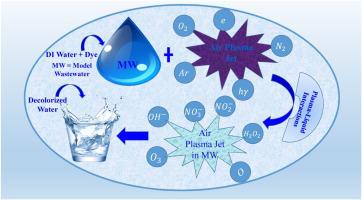Journal of Environmental Chemical Engineering ( IF 7.4 ) Pub Date : 2020-09-23 , DOI: 10.1016/j.jece.2020.104504 M.M. Rashid , Manjushree Chowdhury , M.R. Talukder

|
Textile wastewaters (WW) as released from textile industries damage aquatic environment and thereby create threat to plants and animals. To overcome the problems associated with wastewaters, the plasma technology can be an alternative approach for the reduction of effluents dissolved in textile WWs. In this present study, the degradation of textile dye model WWs is carried out using underwater parallel-multi-tube atmospheric pressure air discharge plasma jet. The investigation reveals that: is decreased, while electrical conductivity () is increased in the deionized (DI) waters and model WWs with increasing plasma treatment duration. The Concentrations of , and in model WWs are decreased compared to that of DI water with treatment duration, but is increased. The decrease in , and suggest that they participate in the dissociation processes of textile dyes. UV–vis spectroscopic measurements show that almost 70 % of dyes were degraded within 10 min of treatments but the remaining 30 % was taken a longer time. FTIR spectroscopic measurements reveal that the amines and alkynes are likely to be produced through oxidative processes of azo-bonds and nitrogen containing functional groups with the interactions of and radical. A fraction of organic nitrogen can be converted to nitrites through oxidation for which the concentration of nitrite is increasing with treatment duration. The proposed environment friendly plasma technology can alternatively be adapted to the reduction of effluents as dissolve in textile WW.
中文翻译:

水下平行多管空气放电等离子体射流处理纺织废水
从纺织工业中释放出来的纺织废水会破坏水生环境,从而对动植物造成威胁。为了克服与废水相关的问题,等离子体技术可以作为减少溶解在纺织品废水中的废水的替代方法。在本研究中,使用水下平行多管大气压空气放电等离子体射流进行纺织品染料模型WWs的降解。调查显示: 降低,而电导率(在去离子(DI)水和模型WW中,随着血浆处理时间的增加,)会增加。浓度, 和 与去离子水相比,模型WW中的处理时间随着处理时间的延长而降低,但是 增加。减少, 和 表明他们参与了纺织染料的离解过程。紫外可见光谱测量表明,在处理10分钟内,将近70%的染料被降解,而其余30%的染料需要更长的时间。FTIR光谱测量表明,胺和炔烃很可能是通过偶氮键和含氮官能团的氧化过程与 和 激进。一部分有机氮可通过氧化转化为亚硝酸盐,为此亚硝酸盐的浓度随处理时间的延长而增加。提议的环境友好型等离子体技术可以替代地适用于减少溶解在纺织品WW中的废水。











































 京公网安备 11010802027423号
京公网安备 11010802027423号